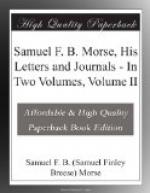“August 23. To-day I went to Potsdam to see Baron Humboldt, and had a delightful interview with this wonderful man. Although I had met with him at the soirees of Baron Gerard, the distinguished painter, in Paris in 1822, and afterward at the Academy of Sciences, when my Telegraph was exhibited to the assembled academicians in 1838, I took letters of introduction to him from Baron Gerolt, the Prussian Minister. But they were unnecessary, for the moment I entered his room, which is in the Royal Palace, he called me by name and greeted me most kindly, saying, as I presented my letters: ’Oh! sir, you need no letters, your name is a sufficient introduction’; and so, seating myself, he rapidly touched upon various topics relating to America.”
On the margin of a photograph of himself, presented to Morse by the baron, is an inscription in French of which the following is a translation:—
To Mr. S.F.B. Morse, whose philosophic and useful labors have rendered his name illustrious in two worlds, the homage of the high and affectionate esteem of Alexander Humboldt.
POTSDAM, August 1856.
The next thirty days were spent in showing the beauties of Cologne, Aix-la-Chapelle, Brussels and Paris to his wife and niece, and in the latter part of September the little party returned to London. Here Morse resumed his experiments with Dr. Whitehouse and Mr. Bright, and on October 3, he reports to Mr. Field:—
“As the electrician of the New York, Newfoundland and London Telegraph Company, it is with the highest gratification that I have to apprise you of the result of our experiments of this morning upon a single continuous conductor of more than two thousand miles in extent, a distance, you will perceive, sufficient to cross the Atlantic Ocean from Newfoundland to Ireland.
“The admirable arrangements made at the Magnetic Telegraph office in Old Broad Street for connecting ten subterranean gutta-percha insulated conductors of over two hundred miles each, so as to give one continuous length of more than two thousand miles, during the hours of the night when the Telegraph is not commercially employed, furnished us the means of conclusively settling by actual experiment the question of the practicability as well as the practicality of telegraphing through our proposed Atlantic cable.... I am most happy to inform you that, as a crowning result of a long series of experimental investigation and inductive reasoning upon this subject, the experiments under the direction of Dr. Whitehouse and Mr. Bright which I witnessed this morning—in which the induction-coils and receiving-magnets, as modified by these gentlemen, were made to actuate one of my recording instruments —have most satisfactorily resolved all doubts of the practicability as well as practicality of operating the Telegraph from Newfoundland to Ireland.”




